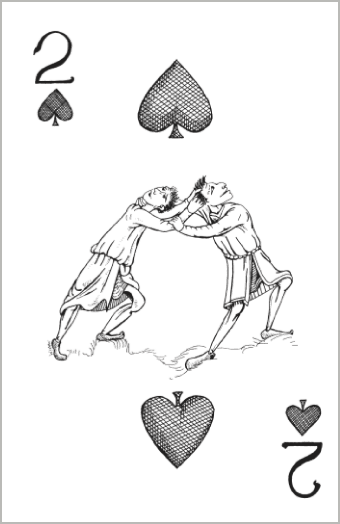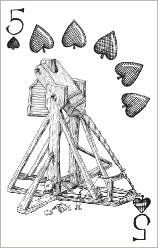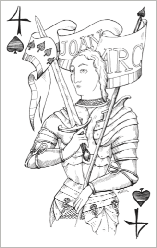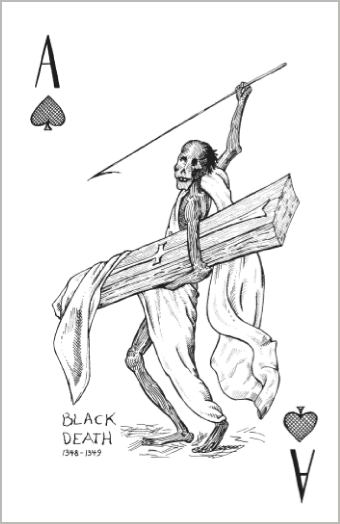Are these REALLY Renaissance playing cards?
 When most folks say “The Renaissance”, they are referring to the “Italian Renaissance” which ran from the 1300s to the 1600s. It started in Italy and then spread across Europe.
When most folks say “The Renaissance”, they are referring to the “Italian Renaissance” which ran from the 1300s to the 1600s. It started in Italy and then spread across Europe.
My Renaissance Playing Cards are "54 different drawings spanning the years 1066 to 1400". Huh? They start before the Italian renaissance! What gives here? The short answer is my cards are not all from the period of the Italian Renaissance!
Now comes the dreaded Long Answer.
There were at least four renaissances.
The term "Renaissance" was coined around 1830. It was used to look backwards from that point in time. The people living in “the Renaissance’ would not have used that term that way. It’s kind of like the term “Dark Ages” which has been gradually falling out of favor. Or how "The Great War" later became "World War One."
Different scholars have chopped up the years into different eras, but apparently there were four official renaissances starting in the eighth century. The first was the Carolingian Renaissance, then the Ottonian Renaissance, then the 12th Century Renaissance, and the fourth is called the Italian Renaissance. The fourth, or Italian, Renaissance is what most people think of as “The Renaissance” mainly because of all the artwork that exploded out of Italy. But it is also focused on because in the earlier periods the changes were mostly confined to the clergy or the court or just some section of Europe. In the Italian Renaissance there were many farther reaching changes in society in general which gradually spread to other countries.
 The first three renaissance periods are also considered part of the Middle Ages.
The first three renaissance periods are also considered part of the Middle Ages.
Just to further confuse the already bored, sometimes the Ottonian Renaissance is called the Renaissance of the 10th Century or the Year 1000 Renewal because it ran from the end of the 10th into the 11th century. One guy wanted to call it the 'third Carolingian Renaissance’ in order to include Charlemagne’s reign, thereby either clarifying things or simply stirring the historical pot.
“Charles H. Haskins was the first historian to write extensively about a renaissance that ushered in the High Middle Ages starting about 1070. In 1927, he wrote that:
[The 12th century in Europe] was in many respects an age of fresh and vigorous life. The epoch of the Crusades, of the rise of towns, and of the earliest bureaucratic states of the West, it saw the culmination of Romanesque art and the beginnings of Gothic; the emergence of the vernacular literatures; the revival of the Latin classics and of Latin poetry and Roman law; the recovery of Greek science, with its Arabic additions, and of much of Greek philosophy; and the origin of the first European universities. The 12th century left its signature on higher education, on the scholastic philosophy, on European systems of law, on architecture and sculpture, on the liturgical drama, on Latin and vernacular poetry…” Quote inside of a quote from Wikipedia, http://en.wikipedia.org/wiki/Renaissance_of_the_12th_century
 For me, the renaissance is the recovery after the fall of Rome. It came in fits and starts, here and there. From my personal survey of the “common folk” most people simply lump all this together. If I mentioned Shakespeare, Da Vinci, the Notre Dame cathedral, Joan of Arc, and some illuminated manuscripts such as the Book of Kells, they tend to be of one mental category.
For me, the renaissance is the recovery after the fall of Rome. It came in fits and starts, here and there. From my personal survey of the “common folk” most people simply lump all this together. If I mentioned Shakespeare, Da Vinci, the Notre Dame cathedral, Joan of Arc, and some illuminated manuscripts such as the Book of Kells, they tend to be of one mental category.
Of course, I didn’t know all these details when I started this project. I love to study history, the only things that are hard for me to remember are names and dates. Thus my “C” in high school History, earned more by enthusiasm than accuracy. When someone brought up the question "Are these REALLY Renaissance Playing Cards?", I mentioned it to my father, a wellspring of historical accuracy. He brought me up to speed on the bigger picture.
There seem to be three levels of how folks think about all this. First, those who attribute anything that has a “renaissance feel” to the Renaissance, regardless of the year. Second, those who see the Italian Renaissance as The Renaissance. And third, those who delve a bit deeper and see multiple renaissances which were all part of a continuum.
 In the final analysis, you get to decide for yourself! The cards were and are simply meant to be fun. Hopefully that spirit survives these autopsies.
In the final analysis, you get to decide for yourself! The cards were and are simply meant to be fun. Hopefully that spirit survives these autopsies.
Whew! Now I go back to forgetting the names and dates…my memories are like ice cubes in a sieve.
More info here:
http://en.wikipedia.org/wiki/The_Renaissance
http://en.wikipedia.org/wiki/Medieval_renaissances
http://en.wikipedia.org/wiki/Ottonian_Renaissance
http://en.wikipedia.org/wiki/Carolingian_Renaissance
http://en.wikipedia.org/wiki/Renaissance_of_the_12th_century